All flip-flops can be divided into four basic types: SR, JK, D and T. They differ in the number of inputs and in the response invoked by different value of input signals.
Table of Contents
SR FlipFlop
A flip-flop circuit can be constructed from two NAND gates or two NOR gates. These flip-flops are shown in Figure. Each flip-flop has two outputs, Q and Q’, and two inputs, set and reset. This type of flip-flop is referred to as an SR flip-flop.
SR Flipflop truth table
VHDL Code for SR FlipFlop
library ieee; use ieee. std_logic_1164.all; use ieee. std_logic_arith.all; use ieee. std_logic_unsigned.all; entity SR_FF is PORT( S,R,CLOCK: in std_logic; Q, QBAR: out std_logic); end SR_FF; Architecture behavioral of SR_FF is begin PROCESS(CLOCK) variable tmp: std_logic; begin if(CLOCK='1' and CLOCK'EVENT) then if(S='0' and R='0')then tmp:=tmp; elsif(S='1' and R='1')then tmp:='Z'; elsif(S='0' and R='1')then tmp:='0'; else tmp:='1'; end if; end if; Q <= tmp; QBAR <= not tmp; end PROCESS; end behavioral;
D FlipFlop
The D flip-flop shown in figure is a modification of the clocked SR flip-flop. The D input goes directly into the S input and the complement of the D input goes to the R input. The D input is sampled during the occurrence of a clock pulse. If it is 1, the flip-flop is switched to the set state (unless it was already set). If it is 0, the flip-flop switches to the clear state.
D Flipflop truth table
VHDL Code for D FlipFlop
library ieee; use ieee. std_logic_1164.all; use ieee. std_logic_arith.all; use ieee. std_logic_unsigned.all; entity D_FF is PORT( D,CLOCK: in std_logic; Q: out std_logic); end D_FF; architecture behavioral of D_FF is begin process(CLOCK) begin if(CLOCK='1' and CLOCK'EVENT) then Q <= D; end if; end process; end behavioral;
JK FlipFlop
A JK flip-flop is a refinement of the SR flip-flop in that the indeterminate state of the SR type is defined in the JK type. Inputs J and K behave like inputs S and R to set and clear the flip-flop (note that in a JK flip-flop, the letter J is for set and the letter K is for clear).
JK Flipflop truth table
VHDL Code for JK FlipFlop
library ieee; use ieee. std_logic_1164.all; use ieee. std_logic_arith.all; use ieee. std_logic_unsigned.all; entity JK_FF is PORT( J,K,CLOCK: in std_logic; Q, QB: out std_logic); end JK_FF; Architecture behavioral of JK_FF is begin PROCESS(CLOCK) variable TMP: std_logic; begin if(CLOCK='1' and CLOCK'EVENT) then if(J='0' and K='0')then TMP:=TMP; elsif(J='1' and K='1')then TMP:= not TMP; elsif(J='0' and K='1')then TMP:='0'; else TMP:='1'; end if; end if; Q<=TMP; Q <=not TMP; end PROCESS; end behavioral;
T FlipFlop
The T flip-flop is a single input version of the JK flip-flop. As shown in figure, the T flip-flop is obtained from the JK type if both inputs are tied together. The output of the T flip-flop “toggles” with each clock pulse.
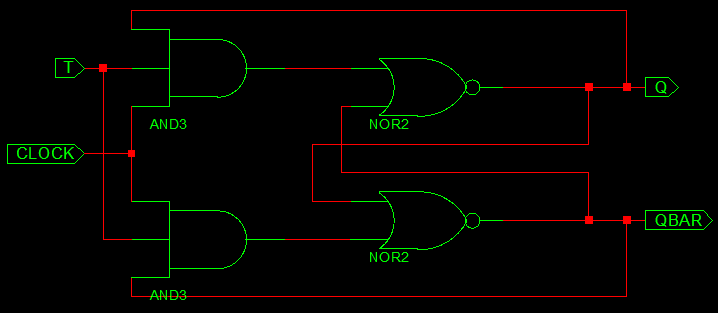
T Flipflop truth table
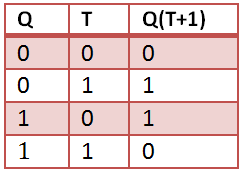
VHDL Code for T FlipFlop
library IEEE; use IEEE.STD_LOGIC_1164.ALL; entity T_FF is port( T: in std_logic; Clock: in std_logic; Q: out std_logic); end T_FF; architecture Behavioral of T_FF is signal tmp: std_logic; begin process (Clock) begin if Clock'event and Clock='1' then if T='0' then tmp <= tmp; elsif T='1' then tmp <= not (tmp); end if; end if; end process; Q <= tmp; end Behavioral;


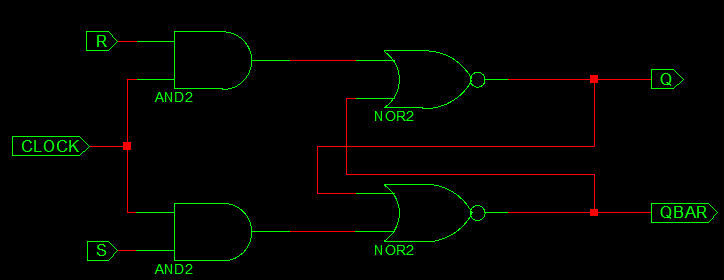
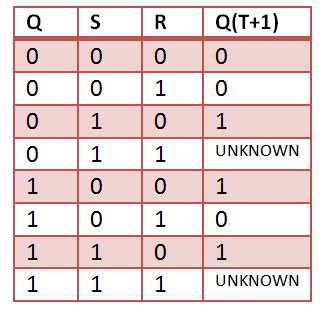

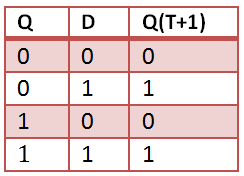

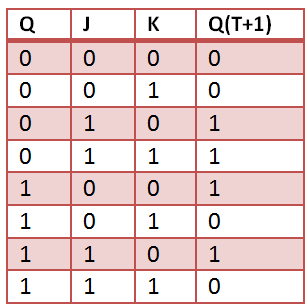
Kindly Correct your code . There are some minor mistakes .
I am not getting the correct values in the waveform with clk=1. Why is it happening?
Please, for the love of code, use indentations preferably with tabulations.
Can I know jk flip-flop using d flip-flop with test bench
nice
Easy and fast way to learn codes for flipflops
The presented solutions have many issues:
– The images don’t reflect the VHDL code, because the images show memory elements, which are state triggered (latch), whereas the VHDL code is edge triggered (flip-flop).
– Th D-flip-flop uses NAND gates, wheras all other flip-flops have and gates to “gate” the clock signal.
– Another error is that output Q in the JK implementation has a multiple driver problem.
– The D and T flip-flops have no QBAR output
– The truth table for the RS base-latch is wrong, because for R=S=1 the outputs Q and QBAR are not unknown. They have a value! It is unknown, what value will survive, while transitioning from R=S=1 (not allowed input combination) to R=S=0 (save value), because in most cases it’s not possible to predict if the transition goes the path S=0;R=1 or S=1;R=0. So for a very short time, between “not allowed” and “save” there will be either set or reset applied to the latch.
Regards
Patrick